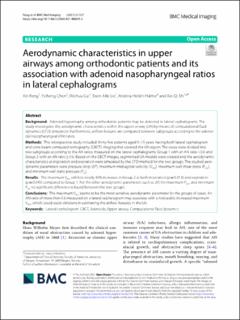| dc.contributor.author | Feng, Xin | |
| dc.contributor.author | Chen, Yicheng | |
| dc.contributor.author | Cai, Weihua | |
| dc.contributor.author | Lie, Stein Atle | |
| dc.contributor.author | Hellén-Halme, Kristina | |
| dc.contributor.author | Shi, Xie-Qi | |
| dc.date.accessioned | 2022-02-08T13:58:54Z | |
| dc.date.available | 2022-02-08T13:58:54Z | |
| dc.date.created | 2021-09-01T20:43:32Z | |
| dc.date.issued | 2021 | |
| dc.identifier.issn | 1471-2342 | |
| dc.identifier.uri | https://hdl.handle.net/11250/2977757 | |
| dc.description.abstract | Background
Adenoid hypertrophy among orthodontic patients may be detected in lateral cephalograms. The study investigates the aerodynamic characteristics within the upper airway (UA) by means of computational fluid dynamics (CFD) simulation. Furthermore, airflow features are compared between subgroups according to the adenoidal nasopharyngeal (AN) ratios.
Methods
This retrospective study included thirty-five patients aged 9–15 years having both lateral cephalogram and cone beam computed tomography (CBCT) imaging that covered the UA region. The cases were divided into two subgroups according to the AN ratios measured on the lateral cephalograms: Group 1 with an AN ratio < 0.6 and Group 2 with an AN ratio ≥ 0.6. Based on the CBCT images, segmented UA models were created and the aerodynamic characteristics at inspiration and expiration were simulated by the CFD method for the two groups. The studied aerodynamic parameters were pressure drop (ΔP), maximum midsagittal velocity (Vms), maximum wall shear stress (Pws), and minimum wall static pressure (Pw).
Results
The maximum Vms exhibits nearly 30% increases in Group 2 at both inspiration (p = 0.013) and expiration (p = 0.045) compared to Group 1. For the other aerodynamic parameters such as ΔP, the maximum Pws, and minimum Pw, no significant difference is found between the two groups.
Conclusions
The maximum Vms seems to be the most sensitive aerodynamic parameter for the groups of cases. An AN ratio of more than 0.6 measured on a lateral cephalogram may associate with a noticeably increased maximum Vms, which could assist clinicians in estimating the airflow features in the UA. | en_US |
| dc.language.iso | eng | en_US |
| dc.publisher | BMC | en_US |
| dc.rights | Navngivelse 4.0 Internasjonal | * |
| dc.rights.uri | http://creativecommons.org/licenses/by/4.0/deed.no | * |
| dc.title | Aerodynamic characteristics in upper airways among orthodontic patients and its association with adenoid nasopharyngeal ratios in lateral cephalograms | en_US |
| dc.type | Journal article | en_US |
| dc.type | Peer reviewed | en_US |
| dc.description.version | publishedVersion | en_US |
| dc.rights.holder | Copyright The Author(s) 2021 | en_US |
| dc.source.articlenumber | 127 | en_US |
| cristin.ispublished | true | |
| cristin.fulltext | original | |
| cristin.qualitycode | 1 | |
| dc.identifier.doi | 10.1186/s12880-021-00659-4 | |
| dc.identifier.cristin | 1930622 | |
| dc.source.journal | BMC Medical Imaging | en_US |
| dc.identifier.citation | BMC Medical Imaging. 2021, 21, 127. | en_US |
| dc.source.volume | 21 | en_US |

